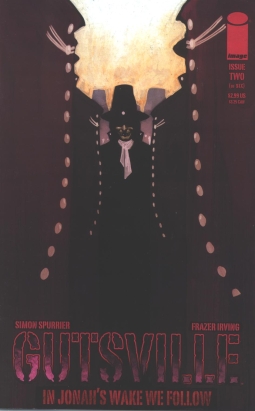Gutsville #2
By Jason Mott
November 7, 2007 - 18:34
Image Comics
Writer(s): Simon Spurrier
Cover Artist(s): Frazer Irving
 |
For those of you who may have missed the first issue of Gutsville, let me just start by saying that there’s a possibility that the inside of your stomach is a very strange, bizarre place inhabited by a population of colonial-era, British-accented, strangely dressed people. Gutsville #2 picks up with Albert Oliphant being fed up with his life inside the gut and, having found a map of the area outside the stomach, has decided to pack it all in and venture out in search of the legendary “second gut.” In the midst of all this, there’s a revolution brewing in the bowels of this story (sorry, couldn’t resist the pun) in which the oppressive, conservative regime of Gutsville is finally being forced into extreme measures to maintain their power base. And here you were thinking that rumbling inside your stomach was just a byproduct of too much bad Mexican food. Now you know better.
Spurrier’s writing is a mix of intrigue and overwriting. As unique and original as the premise for Gutsville is, the overall narrative falls victim to too much “world building.” The voices of Gutsville are so heavily drenched in dialect as to make the reading distracting and downright difficult at times. While there’s no crime in creating a period piece with authentic dialogue, every writer must pay the price of distancing their audience by forcing them to learn (and like) the unique way that your characters speak. Also, Spurrier is obviously far more familiar with his characters than we are. Often times in the story there is a sense that if we had a more intimate knowledge of the characters, their conversations and situations would weigh far more heavily on our minds. But, thus far, that required connection hasn’t been established and, as a result, the writing comes away feeling a bit vacant.
Frazer Irving’s style of artwork is growing on me with each issue of Gutsville. His style is simplistic, yet rich and specifically detailed. He has a very methodical approach to his artwork that appears shallow on the surface, but more and more complicated as the reader studies the page and immerses themselves in the story. If there is a weakness for Irving, it’s that he hasn’t quite gotten the hang of adding gravitas to the quiet moments. When there’s action to be found on the page, Irving shines, but when he tries to slow things down (which happens a lot in Gutsville) he loses his thread and the panels don’t seem to be doing as much work as I’m sure he’d like.
Overall: 3 out of 5. A different kind of read.
Related Articles:
Gutsville #2
Gutsville #1
